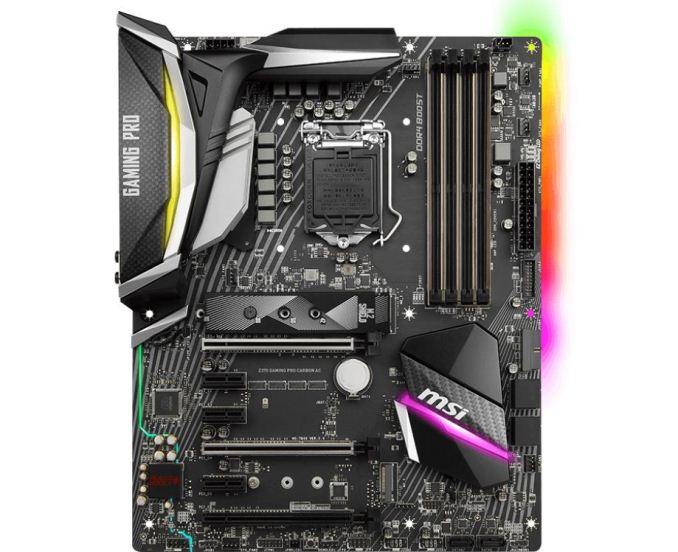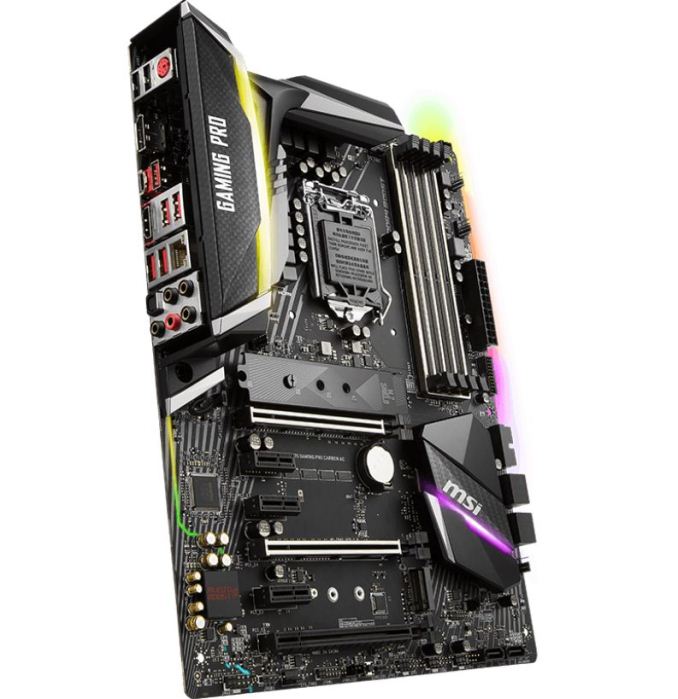Analyzing Z370 for Intel's 8th Generation Coffee Lake: A Quick Look at 50+ Motherboards
by Ian Cutress, Anton Shilov, Joe Shields & Gavin Bonshor on October 20, 2017 2:00 PM ESTMSI Z370 Gaming Pro Carbon and Pro Carbon AC
Sliding down the MSI product stack, the next board is the Z370 Gaming Pro Carbon (offered with and without Wi-Fi depending on the region). While it is still a fully featured board, and sits above almost all of MSI's product stack, it is the smaller sibling to the Godlike Gaming, but will be much cheaper as a result.
The Gaming Pro Carbon AC is based on an all-black PCB using all black slots and ports. It is less flamboyant than the Godlike Gaming with gray stenciling on the board around the socket area and uncovered audio section, as well as the chipset area, but the PCH heatsink is redesigned and has a carbon fiber middle with the MSI name above the integrated RGB LED underneath. The audio separation line, the back panel shroud, and below the ATX 24-pin are where the RGB LEDs hide. Additional RGB headers can be found on the bottom portion of the board and all can be controlled by the Mystic Light App. Two of the three PCIe slots are reinforced, while all of the DIMM slots use the Steel Armor.
Four memory slots on the ATX board give capacity support up to 64GB, with speeds up to DDR4-4000. All the memory slots are reinforced, and use single sided latches, which can make it easier to remove the modules in the presence of a large graphics card but require extra care when putting them in. There are a total of three full-length PCIe slots, two of which are fortified with MSI's Steel Slot. These two are powered by the CPU and run at x16/x0 and x8/x8. The third PCIe slot runs at x4 and gets its lanes from the chipset. The board supports 2-Way SLI from NVIDIA and 3-Way Crossfire from AMD. Lastly, the three x1 slots on the board also fed from the chipset and are sprinkled between the full-length slots.
The board has six SATA ports, four of these are at a 90° angle in the ‘normal’ location, while two others are vertical on the bottom right-hand portion of the board. For the two M.2 slots, the first M.2 slot is located above the first PCIe slot and supports 110mm drives with an included heatsink, while the second M.2 slot sits between the last two full-length slots and will support up to an 80mm drive. There are a total of six four-pin fan connectors on the board, one for the CPU, another for a water pump, and the last four are system fan headers. Audio is handled by an EMI shielded Realtek ALC1220 codec which uses Chemicon audio capacitors. Gone is the monopoly of Killer NICs from the Godlike Gaming, replaced by a lone Intel I219-V gigabit ethernet controller. There is still Wi-Fi on the AC model via a bundled PCIe card, which uses an Intel AC8265 controller.
The USB connectivity starts with the ASMedia 3142 chipset powering a USB 3.1 (10 Gbps) Type-C port and a Type-A port both on the back panel. The chipset handles eight USB 3.1 (5 Gbps) ports in total, with four on the back panel and four more available through internal USB connectors. Last, there are six more USB 2.0 ports with two on the back panel and four more via internal USB connectors. Video outputs for the integrated graphics are in the form of a DisplayPort and a HDMI port. There is a combination PS/2 connector as well as a gold plated audio stack with a SPDIF output to complete the back panel IO.
The Gaming Pro Carbon AC is a well-rounded board with plenty of features and connectivity and gives enthusiasts a good option at the high-end without going all-out like the Godlike Gaming. If wireless connectivity isn't a necessity, the Z370 Gaming Pro Carbon (non AC) is available and does not come with the PCIe wireless card.













83 Comments
View All Comments
risa2000 - Saturday, October 21, 2017 - link
It seems that the PCB which holds the silicon has changed between the 7th and the 8th gen. So they most likely needed to validate the CPU. The fact that they did not move the notch means they just did not want to (could not) introduce a new socket. Either because there were so many of the old ones, or there was no time, or they did not want to push the cost to MB manufacturers to revalidate the new sockets.shabby - Friday, October 20, 2017 - link
For a split second i thought finally some x370 goodness... but no.Shame, shame, shame!
tamalero - Saturday, October 21, 2017 - link
I'm waiting for actual non clown disco BS Threadripper motherboards :(ikjadoon - Friday, October 20, 2017 - link
Amazingly well done. Excellent write-up.AbRASiON - Friday, October 20, 2017 - link
Stupid question, I got the AsRock simple ITX board and it won't turbo my CPU at all (8400) like no turbo PERIOD. It never ever goes over 2763mhz?Anyone got any ideas on this? Am I just stupid and this is normal behaviour or what?
https://forums.anandtech.com/threads/am-i-doing-so...
bernstein - Friday, October 20, 2017 - link
FYI: GIGABYTE Z370N-WiFi is also HDMI 2.0 capableByte - Friday, October 20, 2017 - link
If nothing else, Asus makes some damn good looking boards.docbones - Friday, October 20, 2017 - link
My big question still on the z370 is whats the 390 going to bring? Will the 370 not support a octocore chip?shabby - Friday, October 20, 2017 - link
This is intel we're talking aboot, new chip = new mobo period.Ro_Ja - Saturday, October 21, 2017 - link
Once Kaby Lake E is released, that's a new mobo again.